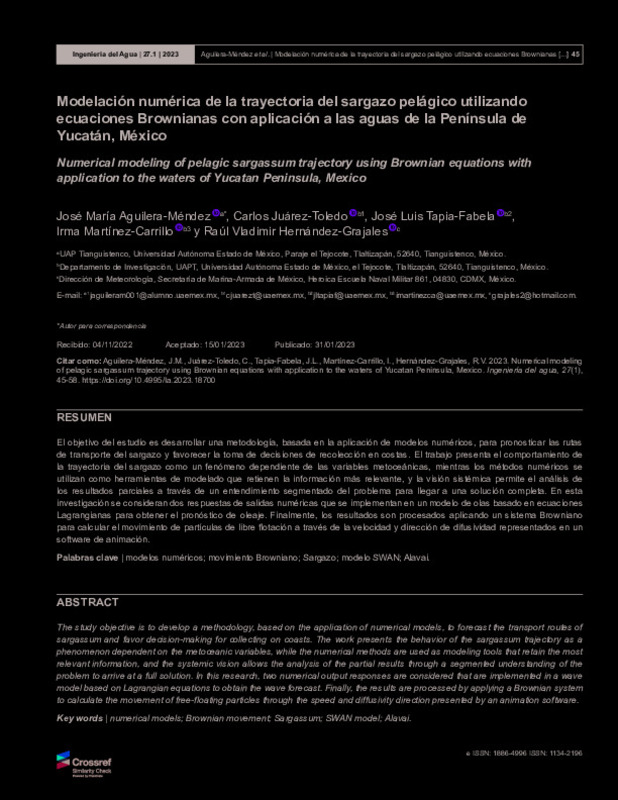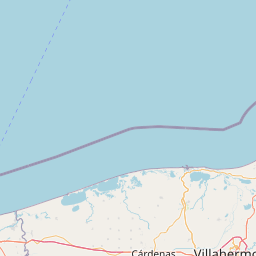Agencia Espacial Europea (ESA). (n.d.). Sentinel-3-olci. Recuperado 5 de enero, 2023, de https://sentinels.copernicus.eu/web/sentinel/technical-guides/sentinel-3-olci/olci-instrument
Aguilera-Méndez, J.M., Juárez-Toledo, C., Martínez-Carrillo, I., & Vera-Popoca, R.I. (2021). Generation of unstructured meshes using Delaunay triangles for tidal analysis of the port of Acapulco, Mexico. Revista de Simulación y Laboratorio, 8(24), 20–27. https://doi.org/10.35429/JSL.2021.24.8.20.27
Aguilera-Méndez, J.M., Juárez-Toledo, C., Martínez-Carrillo, I., & Vera-Popoca, R.I. (2022). Use of unstructured meshes for wave height and particles horizontal displacement analysis in central zone Veracruz, Mexico. ECORFAN Journal-Taiwan, 6(11), 20–27.
[+]
Agencia Espacial Europea (ESA). (n.d.). Sentinel-3-olci. Recuperado 5 de enero, 2023, de https://sentinels.copernicus.eu/web/sentinel/technical-guides/sentinel-3-olci/olci-instrument
Aguilera-Méndez, J.M., Juárez-Toledo, C., Martínez-Carrillo, I., & Vera-Popoca, R.I. (2021). Generation of unstructured meshes using Delaunay triangles for tidal analysis of the port of Acapulco, Mexico. Revista de Simulación y Laboratorio, 8(24), 20–27. https://doi.org/10.35429/JSL.2021.24.8.20.27
Aguilera-Méndez, J.M., Juárez-Toledo, C., Martínez-Carrillo, I., & Vera-Popoca, R.I. (2022). Use of unstructured meshes for wave height and particles horizontal displacement analysis in central zone Veracruz, Mexico. ECORFAN Journal-Taiwan, 6(11), 20–27.
Amorocho, J., & DeVries, J.J. (1980). A new evaluation of the wind stress coefficient over water surfaces. Journal of Geophysical Research, 85(C1), 433. https://doi.org/10.1029/JC085iC01p00433
Arango, D.H.G., & Shchepetkin, D.A.F. (n.d.). Regional Ocean Modeling System. Recuperado 9 de enero, 2023, de https://www.myroms.org/
Automated Data Inquiry for Oil Spills. (2017). https://response.restoration.noaa.gov/adios-desktop
Banas, N.S., & Hickey, B.M. (2005). Mapping exchange and residence time in a model of Willapa Bay, Washington, a branching, macrotidal estuary. Journal of Geophysical Research, 110(C11), C11011. https://doi.org/10.1029/2005JC002950
Banas, N.S., Hickey, B.M., MacCready, P., & Newton, J.A. (2004). Dynamics of Willapa Bay, Washington: A Highly Unsteady, Partially Mixed Estuary. Journal of Physical Oceanography, 34(11), 2413–2427. https://doi.org/10.1175/JPO2637.1
Banas, Neil S., McDonald, P.S., & Armstrong, D.A. (2009). Green Crab Larval Retention in Willapa Bay, Washington: An Intensive Lagrangian Modeling Approach. Estuaries and Coasts, 32(5), 893–905. https://doi.org/10.1007/s12237-009-9175-7
Binding, C.E., Greenberg, T.A., & Bukata, R.P. (2013). The MERIS Maximum Chlorophyll Index; its merits and limitations for inland water algal bloom monitoring. Journal of Great Lakes Research, 39, 100–107. https://doi.org/10.1016/j.jglr.2013.04.005
Binding, C.E., Greenberg, T.A., McCullough, G., Watson, S.B., & Page, E. (2018). An analysis of satellite-derived chlorophyll and algal bloom indices on Lake Winnipeg. Journal of Great Lakes Research, 44(3), 436–446. https://doi.org/10.1016/j.jglr.2018.04.001
Booij, N., Ris, R.C., & Holthuijsen, L.H. (1999). A third-generation wave model for coastal regions 1. Model description and validation. Journal of Geophysical Research: Oceans, 104(C4), 7649–7666. https://doi.org/10.1029/98JC02622
Chávez, V., Uribe-Martínez, A., Cuevas, E., Rodríguez-Martínez, R.E., van Tussenbroek, B.I., Francisco, V., Estévez, M., Celis, L.B., Monroy-Velázquez, L.V., Leal-Bautista, R., Álvarez-Filip, L., García-Sánchez, M., Masia, L., & Silva, R. (2020). Massive Influx of Pelagic Sargassum spp. on the Coasts of the Mexican Caribbean 2014–2020: Challenges and Opportunities. Water, 12(10), 2908. https://doi.org/10.3390/w12102908
Dagestad, K.-F., Röhrs, J., Breivik, Ø., & Ådlandsvik, B. (2018). OpenDrift v1.0: a generic framework for trajectory modelling. Geoscientific Model Development, 11(4), 1405–1420. https://doi.org/10.5194/gmd-11-1405-2018
ECMWF. (n.d.). European Centre for Medium-Range Weather Forecasts. Recuperado 9 de enero, 2023, from https://www.ecmwf.int
Fyrillas, M.M., & Nomura, K.K. (2007). Diffusion and Brownian motion in Lagrangian coordinates. Journal of Chemical Physics, 126(16), 1–9. https://doi.org/10.1063/1.2717185
García, F., Palacio, C., & Garcia, U. (2009). Unestructured Mesh Generation for Numeric Models Implementation. Dyna, 76(157), 17–25.
GEBCO Compilation Group. (2021). GEBCO. https://doi.org/10.5285/c6612cbe-50b3-0cff-e053-6c86abc09f8f
General NOAA Operational Modeling Environment. (2022). Recuperado 20 de enero, 2023, de https://response.restoration.noaa.gov/oil-and-chemical-spills/oil-spills/response-tools/gnome.html
George Mason University (GMU), & National Space Agency (NASA). (n.d.). GrADS. Recuperado 6 de enero, 2023, de http://cola.gmu.edu/grads/
Global Forecast System. (n.d.). Recuperado 30 de noviembre de 2022, de https://www.emc.ncep.noaa.gov/emc/pages/numerical_forecast_systems/gfs.php
Huang, Y., Weisberg, R.H., Zheng, L., & Zijlema, M. (2013). Gulf of Mexico hurricane wave simulations using SWAN: Bulk formula-based drag coefficient sensitivity for Hurricane Ike. Journal of Geophysical Research: Oceans, 118(8), 3916–3938. https://doi.org/10.1002/jgrc.20283
Johns, E.M., Lumpkin, R., Putman, N.F., Smith, R.H., Muller-Karger, F.E., T. Rueda-Roa, D., Hu, C., Wang, M., Brooks, M.T., Gramer, L.J., & Werner, F.E. (2020). The establishment of a pelagic Sargassum population in the tropical Atlantic: Biological consequences of a basin-scale long distance dispersal event. Progress in Oceanography, 182(September 2019), 102269. https://doi.org/10.1016/j.pocean.2020.102269
Key, K. (2010). Triangle (1.9). http://marineemlab.ucsd.edu
Kwon, K., Choi, B.-J., Kim, K.Y., & Kim, K. (2019). Tracing the trajectory of pelagic Sargassum using satellite monitoring and Lagrangian transport simulations in the East China Sea and Yellow Sea. ALGAE, 34(4), 315–326. https://doi.org/10.4490/algae.2019.34.12.11
Legrand, S., Legat, V., & Deleersnijder, E. (2000). Delaunay mesh generation for an unstructured-grid ocean general circulation model. Ocean Modelling, 2(1–2), 17–28. https://doi.org/10.1016/S1463-5003(00)00005-6
Lett, C., Verley, P., Mullon, C., Parada, C., Brochier, T., Penven, P., & Blanke, B. (2008). A Lagrangian tool for modelling ichthyoplankton dynamics. Environmental Modelling & Software, 23(9), 1210–1214. https://doi.org/10.1016/j.envsoft.2008.02.005
Lin, T., Pujos, C., Ou, C., Bi, W., Calvayrac, F., & Wang, Q.A. (2011). Path probability for a Brownian motion. Chinese Science Bulletin, 56(34), 3736–3740. https://doi.org/10.1007/s11434-011-4803-6
Marta-Almeida, M., Ruiz-Villarreal, M., Otero, P., Cobas, M., Peliz, A., Nolasco, R., Cirano, M., & Pereira, J. (2011). OOFɛ: A Python engine for automating regional and coastal ocean forecasts. Environmental Modelling & Software, 26(5), 680–682. https://doi.org/10.1016/j.envsoft.2010.11.015
MM5 Homepage. (2004). https://a.atmos.washington.edu/~ovens/newwebpage/mm5-home.html
National Oceanic and Atmospheric Administration (NOAA). (n.d.-a). Global Forecast System (GFS) [0.5 Deg.]. Recuperado 7 de enero, 2023 de https://data.noaa.gov/dataset/dataset/global-forecast-system-gfs-0-5-deg
National Oceanic and Atmospheric Administration (NOAA). (n.d.-b). NOMADS. Recuperado 7 de enero, 2023, de https://nomads.ncep.noaa.gov/
National Space Agency (NASA). (n.d.). OLCI. Recuperado 5 de enero, 2023, de https://www.earthdata.nasa.gov/sensors/olci
Núñez, P., García, A., Mazarrasa, I., Juanes, J.A., Abascal, A.J., Méndez, F., Castanedo, S., & Medina, R. (2019). A methodology to assess the probability of marine litter accumulation in estuaries. Marine Pollution Bulletin, 144, 309–324. https://doi.org/10.1016/j.marpolbul.2019.04.077
Otero, P., Banas, N.S., & Ruiz-Villarreal, M. (2015). A surface ocean trajectories visualization tool and its initial application to the Galician coast. Environmental Modelling & Software, 66, 12–16. https://doi.org/10.1016/j.envsoft.2014.12.006
Putman, N.F., Lumpkin, R., Olascoaga, M.J., Trinanes, J., & Goni, G.J. (2020). Improving transport predictions of pelagic Sargassum. Journal of Experimental Marine Biology and Ecology, 529, 151398. https://doi.org/10.1016/j.jembe.2020.151398
Schwartz, M., & Brustein, R. (1988). From Lagrangian to Brownian motion. Journal of Statistical Physics, 51(3–4), 585–613. https://doi.org/10.1007/BF01028474
Shewchuk, J.R. (2002). Delaunay refinement algorithms for triangular mesh generation. Computational Geometry, 22(1–3), 21–74. https://doi.org/10.1016/S0925-7721(01)00047-5
Signoret, M., Bulit, C., & Pérez, R. (1998). Patrones de distribución de clorofila a y producción primaria en aguas del Golfo de México y del Mar Caribe. Hidrobiológica, 8(2), 81–88. http://www.redalyc.org/articulo.oa?id=57880201
Skamarock WC, et al. (2008). A description of the advanced research WRF version 3, NCAR Tech. Note, NCAR/TN-468+STR. Natl. Cent. for Atmos. Res. Boulder, Colorado.
Staff. (2019, July 10). 10 cosas que sabemos del sargazo. El Universal, 1. https://www.eluniversal.com.mx/destinos/13-cosas-quesabemos-del-sargazo-en-las-playas-de-quintana-roo
Suárez, A.M., & Martínez-Daranas, B. (2018). La problemática del Sargazo en el caribe. In La problemática del Sargazo en el caribe. Adaptación basada en Ecosistemas: alternativa para la gestión sostenible de los recursos marinos y costeros del Caribe (Vol. 18, pp. 82–94). Instituto de Oceanología.
Suzuki, T. (2011). Wave dissipation over vegetation fields. PhD thesis. TUDelft.
Suzuki, T., & Arikawa, T. (2011). Numerical analysis of bulk drag coefficient in dense vegetation by immersed boundary method. Coastal Engineering Proceedings, 1(32), 48. https://doi.org/10.9753/icce.v32.waves.48
The WAVEWATCH Development Group (WW3DG). (2019). User manual and system documentation of WAVEWATCH III R version 6.07. In Tech. Note 333.
WaveWatch III (WW3-GW) Global Wave Model. (2019). https://data.noaa.gov/dataset/dataset/wavewatch-iii-ww3-global-wavemodel2
Zheng, X., Mayerle, R., Wang, Y., & Zhang, H. (2018). Study of the wind drag coefficient during the storm Xaver in the German Bight using data assimilation. Dynamics of Atmospheres and Oceans, 83, 64–74. https://doi.org/10.1016/j.dynatmoce.2018.06.001
[-]






















